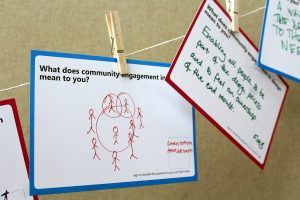We live in a time where the role of civil society in dealing with social, economic and environmental issues becomes more and more essential in the face of reduced resources by the local and national government to support and develop innovative solutions to such issues. In our research at the OU we have worked with many groups over the last 7 years, who initiate and creatively carry out place-making projects to offer local services and help people connect and support one another. In collaboration with various civil society organisations and other support bodies, as well as our strategic partner The Glass-House Community Led Design, we have been advocating the importance of engaging communities in design decision making at all levels and empowering grassroots initiatives and groups to take a lead. Despite developments at a policy level (such as the Localism Act in England or the Community Empowerment Act in Scotland) there is a need for practical resources and sharing of know-how, to help individuals and formal or informal groups develop their skills and ability to lead design projects in their locale.
As part of a research project called Empowering Design Practices, funded by the Arts and Humanities Research Council, we recently delivered a workshop exploring what community engagement in design means and why it is important. The focus of the project is groups who look after historic places of worship and face challenges in sustaining and developing their buildings for the benefit of their wider communities. The workshop attracted community members as well as professionals who support such projects: architects, development officers, funders and members of dioceses.

In the first part of the workshop, we had invited speakers from two projects who successfully and creatively engaged with their communities, to re-imagine and re-develop their buildings. Rev Jane Lees and Andrew Smith, from St Luke’s Church in Oxford, talked about their experiences with their Big Project, completed in 2014, which saw their church transformed into a space that effectively serves worshiping needs alongside offering a variety of activities and services for the wider local community. Clare de Bathe, from Chichester Community Development Trust told the story of how the development of the Graylingwell Chapel started, and how the community engagement process was organised to ensure that the plans take into consideration the needs and aspirations of the local community. The two presentations gave an interesting perspective on the different starting points and different end points in terms of design decisions that projects can have, but also revealed many commonalities in terms of methods and approach to community engagement. Both made some important points about keeping engagement going and being open to the input of people in the community.
We also shared some of our own observations and research findings and facilitated a workshop session on developing an engagement strategy, as well as a number of taster sessions introducing some resources and tools to help with different aspects of the process, from how to use digital media in your design project, to how to structure your thinking and how to collect evidence from community engagement activities.
The film created on the day, is an exploration of what community engagement means from the perspectives of the participants, and also gives a feel of the event and its impact.
The event was also an opportunity to launch a set of resources. The resources are meant primarily for groups looking after historic places of worship, but can indeed be useful for any group thinking to embark in a design project, as well as design professionals. More resources are under development. We invite everyone to have a look, try out the materials and tools offered, pick and choose, adapt or expand them and share them in their networks. Our only request is to come back and talk to us about your experiences!
Check them out at http://www.empoweringdesign.net/edp-resources.html

Leave a Reply